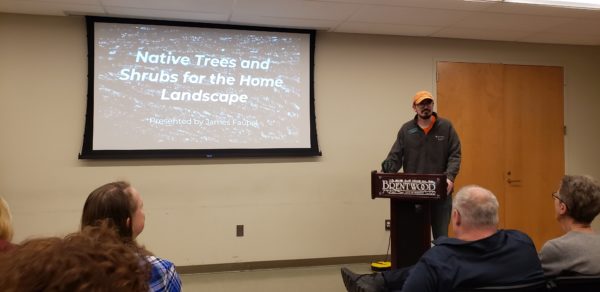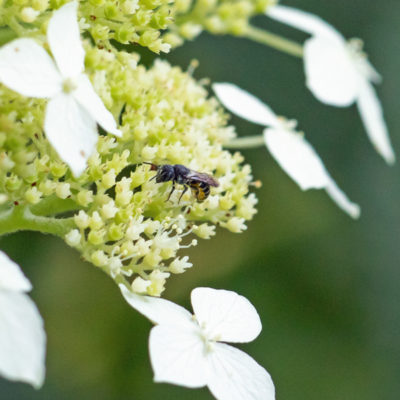Wild Ones Monthly Gathering
15 January 2020
Brentwood Community Center
Attendance: 63 Members and 55 guests
The meeting was opened by our President Marsha Gebhardt. Members and visitors were welcomed and recognized. She immediately went on to introduce our speaker for the night, James Faupel. He is a member of our chapter, a horticulturist and works at the Litzsinger Road Ecology Center.
James’ talk centered on adding native trees and shrubs in the home landscape and getting rid of invasive species like callery pear and bush honeysuckle.

James’ current challenge is the Metropolitan Sewer District project, which is undertaking a major renewal in many spots of the metropolitan area. In the Litzsinger area alone, they have removed over a thousand trees and shrubs in a half-mile area. His role is to use this opportunity to do before and after research, and document the effectiveness of the restoration effort.

James first spoke about the need for natives because of the habitat and food they provide for lepidoptera (butterflies and moths), pollinators and birds. By quoting Doug Tallamy, he showed the numbers many species supports, like oak trees, which support 534 species of lepidoptera caterpillars. If you have Doug Tallamy’s book Bringing Nature Home, you can refer to page 147 for more information.
Instead of planting Callery pears, he suggested the following:
- Serviceberry (Amelanchier arborea)
- Dogwood (Cornus florida)
- Green Hawthorne (Crataegus viridis)
- Yellowwood (Cladrastis kentukea)
- Rusty Blackhaw Viburnum (Viburnum rufidulum)
Instead of bush honeysuckle, autumn olive, border privets, barberries or burning bushes,plant the following:
- Ninebark (Physocarpus opulifolius)
- Hazelnut (Corylus americana)
- Spicebush (Lindera benzoin)
- Gray Dogwood (Cornus racemosa)
- Black Chokeberry (Aronia melanocarpa)
- Prairie Willow (Salix humilis)
- Witch Hazel (Hamamelis virginiana and Hamamelis vernalis)
- Eastern Wahoo (Euonymus atropurpureus)
- Strawberry bush (Euonymus americanus)

As a caution, James urged all to EDUCATE themselves about the genus/species names of plants before buying. Don’t rely on the common name in thinking they are native to our location. Buying plants that are native to our soil and climate location will add to the success of their growth! If you are really serious about creating diversity, James provided many suggestions for your yard with the following books.
These books will to help educate you to the natives in our area.
- The Terrestrial Natural Communities of Missouri by Paul Nelson
- Trees of Missouri Field Guide by Don Kurz
- Native Plants of the Midwest: A Comprehensive Guide by Alan Branhagen
- Illustrated Guide to the Immature Lepidoptera on Oaks in Missouri
Other local resources for information and buying plants include:
- Forest ReLeaf
- Missouri Department of Conservation
- Grow Native! of the Missouri Prairie Foundation
- Missouri Wildflowers Nursery in Jefferson City, MO
- Forrest Keeling Nursery in Elsberry, MO
- Local nurseries, look for the Grow Native! tags
Announcements:
New Wild Ones St. Louis Chapter t-shirts are available to order NOW! The deadline is Saturday, February 22nd.
Volunteer opportunities: Grant mentors are needed for a few grant sites. If interested in more information please email Kevin Mowery
Door prizes:
- Pam Hass – Wild Ones Anniversary bandana
- Diane Linsley – MOBOT 2020 Calendar
- Karen Gallagher – bird puzzle
Leftover seeds were available and many helped themselves.
Submitted by Ginny Johnson, Secretary

